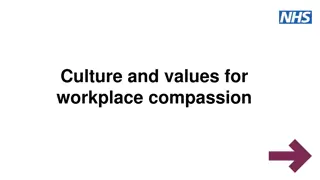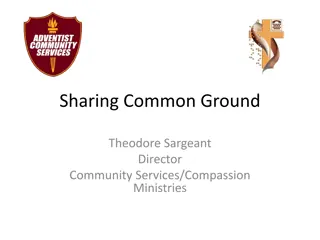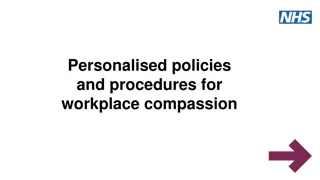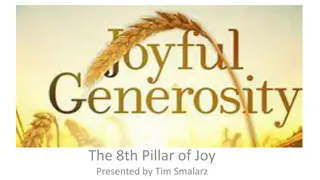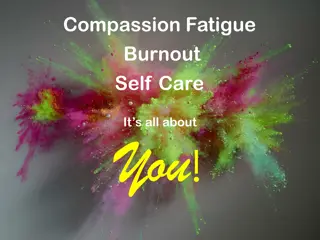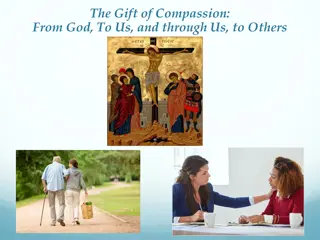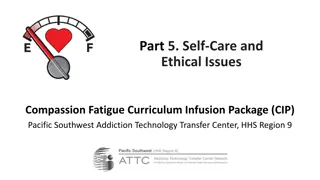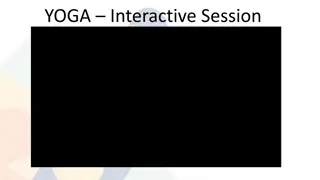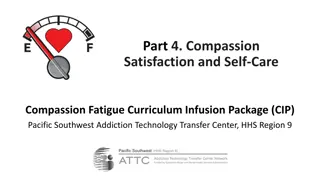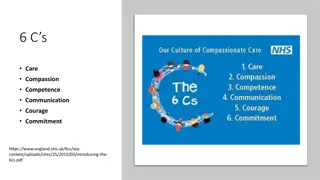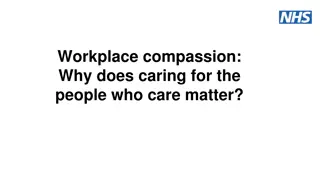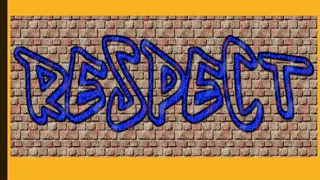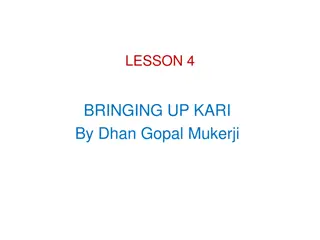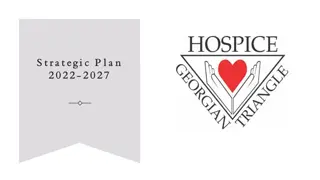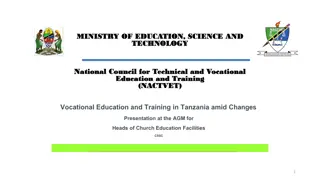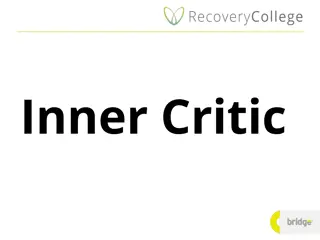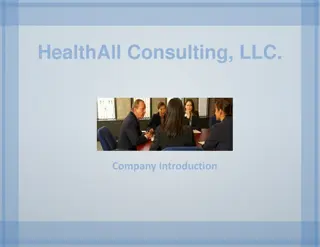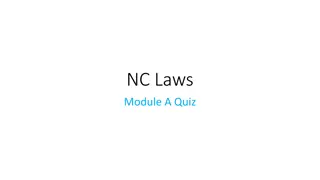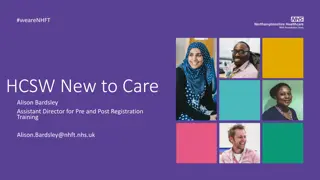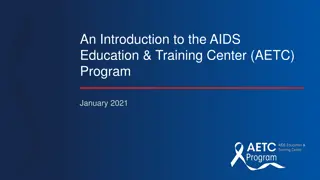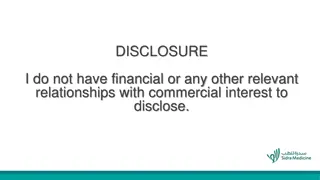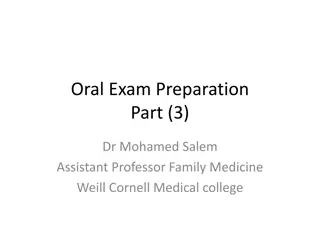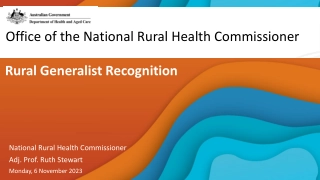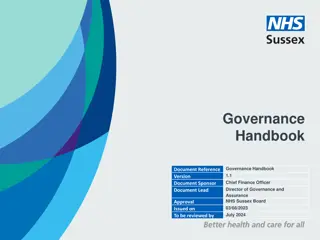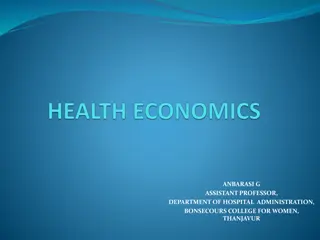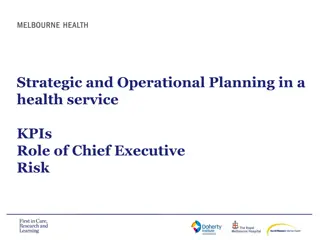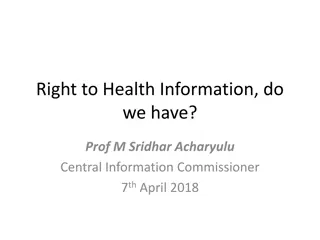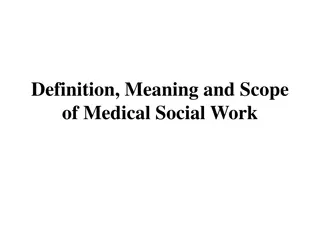Enhancing Compassion in Education and Healthcare
Explore the concept of compassion in education and healthcare, focusing on understanding others' emotions, developing a compassionate approach, and promoting mental well-being. Learn techniques and activities to cultivate compassion, including grounding exercises and the FOFBOC method. Encourage self-care and reflection to enhance interpersonal connections and workplace culture.
Download Presentation

Please find below an Image/Link to download the presentation.
The content on the website is provided AS IS for your information and personal use only. It may not be sold, licensed, or shared on other websites without obtaining consent from the author. Download presentation by click this link. If you encounter any issues during the download, it is possible that the publisher has removed the file from their server.
E N D
Presentation Transcript
Compassionate Education March 2022 CapitalNurse is jointly sponsored by Health Education England, NHS England and NHS Improvement
Compassionate Education Traditional focus on education and developing proficiency in academic, clinical, skills and knowledge Help educators to develop compassionate approach to training and the workplace Need for focus on self-care to promote positive mental health and wellbeing Increase awareness and embed compassion in workplace
What is Compassion? Compassion is understanding how another person is feeling, the emotions they are experiencing Based on empathy, respect and dignity Showing compassion helps people feel cared for and valued Compassion can be learned
Developing a compassionate approach Ask lots of open questions Kipling s Men Listen actively ears, eyes, heart Show understanding through non-verbal cues Reflect back to others
Take Five Beginning or end of training sessions Take five minutes to introduce compassion Can be Asking learners how they are feeling Asking learners to make pledges 5-minute activity as a group Introduce a 5-minute self-care activity Encouraging learners to reflect on how they are feeling
Techniques Everyone is different Different techniques help different people Activities in two groups: Grounding techniques Refocusing techniques
Look deep into nature and you will understand everything better Albert Einstein
FOFBOC Feet on Floor, Body On Chair Sit on a chair with feet resting on the floor Feel your body on the chair Now feel your feet on the floor Think about your legs and how they feel moving onto lower body Focus on your belly, then your breathing Sit and relax for just a couple of minutes tuned into an awareness of your body
Body Awareness You can do this sitting or standing Focus on how your body feels from head to toe, noticing each part in turn Pay attention to hair, neck, shoulders and belly Feel your heartbeat and breathing Consider how you feel temperature, pressure, emotions
5-4-3-2-1 Use your senses and see what you can sense in the world around you. Work backwards from 5 to notice: 5 things you can see 4 things you can hear 3 things you can touch 2 things you can smell 1 thing you can taste
Guided Meditation Short podcasts or video clips Help to disassociate from stressors Three to five minutes https://www.youtube.com/watch?v=TsSbC ntmMHo
3-4-5 Breathing Breathe in for three seconds Hold your breath for four seconds Breathe out for five seconds Repeat for a few minutes
Box Breathing Breathe in counting to four slowly. Feel the air enter your lungs Hold your breath for four seconds Slowly exhale for four seconds Repeat steps above until you feel re-centered.
Hand tracing Take one hand and hold it in your other hand With your forefinger, place the fingertip on your palm Trace up your thumb and up the next finger. Trace all the way around your hand, Repeat using the other hand
4-7-8 Breathing Inhale for four seconds through your nose Hold the breath for seven seconds Exhale for eight seconds through your mouth Repeat this exercise as many times as you can. 30 seconds of deep breathing will help you feel more relaxed and in control.
Visualisation Think about one of your favourite places imagine you are there now: What can you see? What can you feel? What can you smell? What can you hear? What can you taste? What are you doing? Who is there with you? What is the weather like? How are you feeling?
Head, Shoulders, Knees and Toes Try a few simple stretches: Head roll your head round, tilt it back and forth, turn it from side to side Shoulders gently rise your shoulders, up and down. Try rotating them Knees move your knees side to side, swing them apart Toes gently place your feet flat on the ground and slowly rise to your tiptoe, and then back down again.
Mindful Moments Begin your session with a slide showing a photo of nature Ask delegates to focus on the picture, what they see and how they feel for two minutes
Pledges Ask learners to make a pledge for self- care These should be written and may be shared Focus on doing something for themselves Providing pretty paper for them may help
Sample pledges More family time Start taking my full break Give myself one hour every Friday to reflect Look after myself Dedicate 10 minutes after work for mindfulness Actively leaving work at work Gain confidence, relax more
Category thinking Take a category for example: musical instruments, or ice cream flavours Give yourself a minute or two to list as many things from that category as possible.
Recital Think of a poem, song, or book passage you know by heart Recite it quietly to yourself If you say the words aloud, focus on the shape of each word on your lips and in your mouth If you say the words in your head, visualize each word as you d see it on a page.
Count tables (not sheep) Try counting, either single digits: 1 elephant, 2 elephants, 3 elephants Or count through your times tables: 2, 4, 6, 8 6, 12, 18, 24 Or count backwards from 100
These are a few of my favourite things! Create a list of three things you love these could be people, places, objects, foods, animals Visualise each of them, one at a time. What does it look like? Sound like? Feel like? Taste like? Smell like? What does it remind you of? Are there any associated memories?
Be grateful Think of all the things that have gone well for you, all the people who love you, things that make you smile or occasions that made you laugh. Think of three things that you are lucky to have. Cherish these three things Consider keeping a gratitude journal
I remember, I remember I remember, I remember, The house where I was born, The little window where the sun Came peeping in at morn Choose a happy memory. Close your eyes and remember: What are you doing? Where are you? Who s with you? What can you feel?
'My hope is that, one day, formal education will pay attention to what I call education of the heart Dalai Lama
Authors Developed by Desiree Cox, CapitalNurse Tracey Coyne, LNWH James Clay, CNWL Riina Hilton, NELFT References and additional resources available in accompanying document


